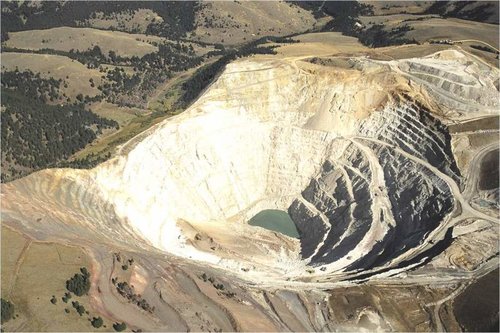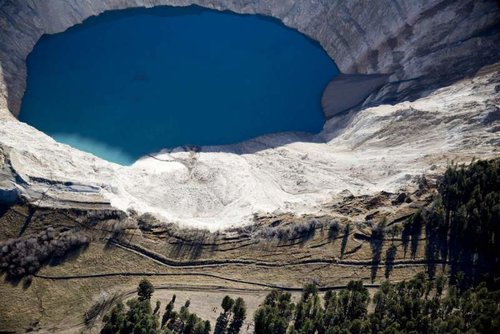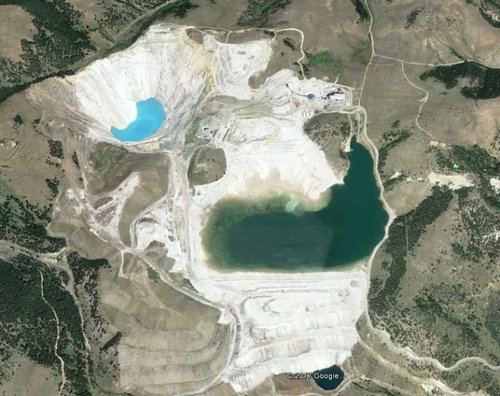onpoint
Well-known member
You askin' Mark and Topgun???
Follow along with the video below to see how to install our site as a web app on your home screen.
Note: This feature may not be available in some browsers.
Honest question. Are there any metals mines that have operated successfully then closed and been remediated properly so that the end result is that the mining company made money and still cleaned up after themselves?
You askin' Mark and Topgun???
That is a great question it would behoove the mining industry to answer in a positive way. For Montanans, Berkeley Pit in Butte stands out as a disaster of enormous magnitude, but also the Pegasus gold mine in the Little Rocky Mountains of north central Montana remains on the forefront. The three hundred good jobs for twenty years now seems a blink of the eye for folks living in the Zortman-Landusky communities. The bankruptcy of Pegasus leaves the reclamation far from complete. The scars left on the face of the Little Rocky Mountains have forever altered that landscape and the continuing water problems leave a very negative attitude toward mining. It will take many successful reclamation efforts to overcome all of that.Honest question. Are there any metals mines that have operated successfully then closed and been remediated properly so that the end result is that the mining company made money and still cleaned up after themselves?



I bet the people who work at that mine in Minnesota are grateful for a the lease being renewed. All those who don't use any mined materials can now bash me.
I think 1_Pointer provided a successful example, though I'd wager that strip mining is far easier to reclaim than 1500 foot deep pits and millions of tons of slag.
Here's a photo of the pit near where I live when it was running. Clancy Creek, the road that gave access to public, and the entire mountain that is an active landslide are on the left side of the photo.
View attachment 78400
And here is a more recent photo taken from a different angle, above where Clancy Creek has been forced into a pipe. The road system and terracing have eroded away, and the mine has quit pumping the water. You can see the fissures in the earth where the mountain has started to slide running across the bottom of the photo.
View attachment 78401
Now, see the scale of the pit relative to the tailings pond, which is where the bad water is. The pit is in the northwest portion of this photo, the tailings pond and the bad soil surrounded by it are south of the pit, and I would guess are a much larger problem to deal with.
View attachment 78402
I don't know how they go about reclaiming something like this.
For the tailing ponds (because they are lined to prevent leaching) you pile dirt on it and then re-establish vegetation on the dirt.
How long do the liners last before releasing toxic content into groundwater? How often to the liners or caps fail, and what causes failure? Who pays victims of groundwater contamination when these fail? How often are at-fault mines held accountable for disease, degradation of water quality, habitat and species loss, compared to those costs borne by taxpayers, and compared to reclamation that never happens?
Those are the ways the real costs of mining/drilling get passed to federal landowners, after the profits are taken by the extractors. I see timber, grazing, extraction as viable uses of public land, if the industry paid those costs rather than dumping the unpaid bills and environmental losses/costs on whoever is left after the rigs and blasters leave.
I'll take that as a no.
How long the liners last depends on the material of the liner. Some liners can last many lifetimes or even forever if not disturbed. It will also depend on the depth of the ground water (can be 0 -1,200 ft below the surface). There are a lot of variables that go into liners, which is probably a question better suited for an environmental engineer.
How often do the liners fail? Not very often, but if one happens it is sure to be in the news. If they are caught to be failing then, the material has to be moved and dug up to replace the liner.
How often are at fault mines held accountable for disease, degradation of water quality, habitat and species loss? Disease passed from mining activities to humans falls under the CDC and wildlife is under the EPA. If it is proven that the mine owner is the one that caused the epidemic, then the mine will pay. Degradation of water quality, this is a permit and a mine that violates the permit has to deal with the EPA (which has huge fines). If you are really worried about water quality, then I wouldn't drink Coors or any water other than spring water. Some places recycle human waste into drinking water and as long as it meets the requirements it is good to go. In facilities that have to discharge water there are certain requirements for levels of some elements that have to be met. Environmental engineering is a vast field, but their job is to come up with solutions for these issues. As far as habitat loss, this is the purpose of doing reclamation. Part of some mining companies PR efforts are to show reclaimed land. As far as species loss, I am not aware that a mining activity that has caused a species to become extinct. As far as reclamation projects that never happen, there are a few things. One being it might reopen again. One a company runs out of money, which would put burden on the tax payers - however this is a reason for the bond that is set forth.
One of the issues that have happened in the past have been from shady mining activities, but with modern technology and the field of environmental engineering the future of mining and environmental impact looks a lot better. It still probably has work to go moving forward, but it is not what it was. There is a lot of things that the bigger mining companies do right now that will help in the future. The smaller outfits like in the Gold Rush show are very poor examples of miners and of mining in general (One of the reasons, why they no longer operate in the states)
Thanks for the thorough reply. What EPA?
Some of the non-working force
Hmm, the issue is complex. Nailed it, Elkduds.
There are two ways.
Either fill it back full of dirt or fill it full of water.
Barth Pit in Nevada is a fishable lake that used to be an open pit mine.
For the tailing ponds (because they are lined to prevent leaching) you pile dirt on it and then re-establish vegetation on the dirt.
Thanks for the information, Dudeabides. Refreshing to read vs the typical HT partisan garbage.